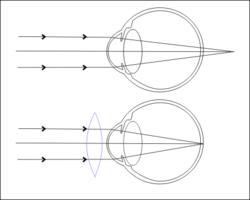Hyperopia (long-sightedness)

Hyperopia (commonly called
‘long-sightedness’) is an eye issue that affects almost one-fourth of
Australians. If you have hyperopia, you are unable to see objects close
to you clearly; however, you can see objects at long distances, which is
why it is called long-sightedness..
In order to see clearly, your
cornea and lens must be able to focus light (or refract it) onto your
retina (Figure 1). When your eye has a length or shape that is not
ideal, light is focused too late (i.e. behind the eye, creating a blurry
image on your retina), which is hyperopia (Figure 2). Young people with
mild to moderate hyperopia are often able to see clearly because their
eyes can adjust, or accommodate, to increase the eye's focusing ability.
However, at later years the eye gradually loses the ability to
accommodate and blurred vision becomes more apparent.
Hyperopia is
often present from birth when the eyeball is smaller (i.e. a child's
eyeball). A family history of hyperopia, however, can also contribute to
its development.
The most common symptoms of hyperopia are
eyestrain and headaches following close work. Irritability and
nervousness after prolonged concentration may also occur.
Treatment
In
order to treat hyperopia, you must first get diagnosed by an
optometrist or an ophthalmologist. Once you have been diagnosed, how
your hyperopia is treated will depend on certain factors, including your
age, occupation, and regular activities. Most commonly, hyperopia is
treated with glasses or contact lenses that are used to focus light
correctly on to the retina (Figures 3, 4 and 5). Some people opt for
laser surgery as this means they won’t need glasses or contact lenses;
however, laser surgery is only useful for low to moderate cases of
hyperopia.
|